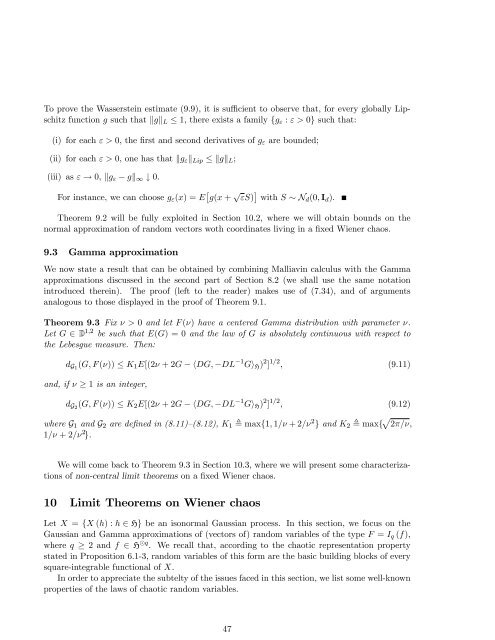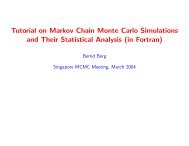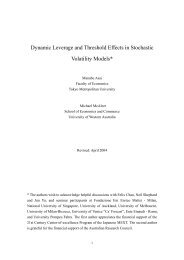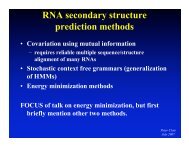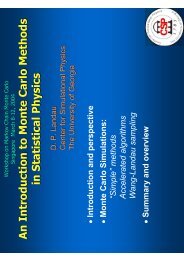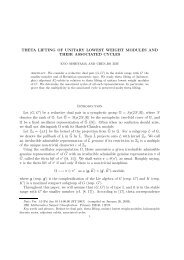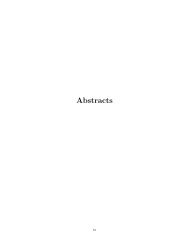Stein's method, Malliavin calculus and infinite-dimensional Gaussian
Stein's method, Malliavin calculus and infinite-dimensional Gaussian
Stein's method, Malliavin calculus and infinite-dimensional Gaussian
You also want an ePaper? Increase the reach of your titles
YUMPU automatically turns print PDFs into web optimized ePapers that Google loves.
To prove the Wasserstein estimate (9.9), it is su¢ cient to observe that, for every globally Lipschitz<br />
function g such that kgk L 1, there exists a family fg " : " > 0g such that:<br />
(i) for each " > 0, the …rst <strong>and</strong> second derivatives of g " are bounded;<br />
(ii) for each " > 0, one has that kg " k Lip kgk L ;<br />
(iii) as " ! 0, kg " gk 1 # 0.<br />
For instance, we can choose g " (x) = E g(x + p "S) with S N d (0; I d ).<br />
Theorem 9.2 will be fully exploited in Section 10.2, where we will obtain bounds on the<br />
normal approximation of r<strong>and</strong>om vectors woth coordinates living in a …xed Wiener chaos.<br />
9.3 Gamma approximation<br />
We now state a result that can be obtained by combining <strong>Malliavin</strong> <strong>calculus</strong> with the Gamma<br />
approximations discussed in the second part of Section 8.2 (we shall use the same notation<br />
introduced therein). The proof (left to the reader) makes use of (7.34), <strong>and</strong> of arguments<br />
analogous to those displayed in the proof of Theorem 9.1.<br />
Theorem 9.3 Fix > 0 <strong>and</strong> let F () have a centered Gamma distribution with parameter .<br />
Let G 2 D 1;2 be such that E(G) = 0 <strong>and</strong> the law of G is absolutely continuous with respect to<br />
the Lebesgue measure. Then:<br />
d G1 (G; F ()) K 1 E[(2 + 2G hDG; DL 1 Gi H ) 2 ] 1=2 ; (9.11)<br />
<strong>and</strong>, if 1 is an integer,<br />
d G2 (G; F ()) K 2 E[(2 + 2G hDG; DL 1 Gi H ) 2 ] 1=2 ; (9.12)<br />
where G 1 <strong>and</strong> G 2 are de…ned in (8.11)–(8.12), K 1 , maxf1; 1= + 2= 2 g <strong>and</strong> K 2 , maxf p 2=;<br />
1= + 2= 2 g.<br />
We will come back to Theorem 9.3 in Section 10.3, where we will present some characterizations<br />
of non-central limit theorems on a …xed Wiener chaos.<br />
10 Limit Theorems on Wiener chaos<br />
Let X = fX (h) : h 2 Hg be an isonormal <strong>Gaussian</strong> process. In this section, we focus on the<br />
<strong>Gaussian</strong> <strong>and</strong> Gamma approximations of (vectors of) r<strong>and</strong>om variables of the type F = I q (f),<br />
where q 2 <strong>and</strong> f 2 H q . We recall that, according to the chaotic representation property<br />
stated in Proposition 6.1-3, r<strong>and</strong>om variables of this form are the basic building blocks of every<br />
square-integrable functional of X.<br />
In order to appreciate the subtelty of the issues faced in this section, we list some well-known<br />
properties of the laws of chaotic r<strong>and</strong>om variables.<br />
47


